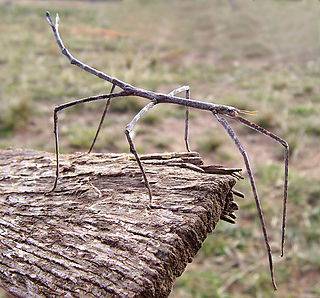
The family Phylliidae contains the extant true leaf insects or walking leaves, which include some of the most remarkably camouflaged leaf mimics (mimesis) in the entire animal kingdom. They occur from South Asia through Southeast Asia to Australia. Earlier sources treat Phylliidae as a much larger taxon, containing genera in what are presently considered to be several different families.

The Euphasmatodea, also known by its junior synonym Verophasmatodea is a suborder of the Phasmatodea, which contains the vast majority of the extant species of stick and leaf insects, excluding the Timematodea. The oldest record of Euphasmatodea is Araripephasma from the Crato Formation of Brazil, dating to the Aptian stage of the Early Cretaceous.

The Phasmatidae are a family of the stick insects. They belong to the superfamily Anareolatae of suborder Verophasmatodea.

The Phasmatinae are a subfamily of stick insects in the family Phasmatidae. They contain at least three tribes; Bradley and Galil corrected the spelling to "Phasmatinae" and provides a key to tribes.

Pulchriphyllium giganteum, commonly known as the Giant Malaysian Leaf insect, is a species of leaf insects described from Malaysia by Hausleithner in 1984 and placed in the genus Pulchriphyllium since 2021. Pulchriphyllium giganteum is the largest species belonging to the genus Pulchriphyllium reaching 105 mm in size. They are found most abundantly in the west Malaysian tropics. The females typically have large elytra that lie edge to edge on the abdomen and tend to lack hind wings making them usually flightless. Males have small elytra and sometimes transparent non-leaflike functional hind wings. Pulchriphyllium giganteum found in the wild tend to be mostly females and the first male of this species was not found until 1994. In captivity, the species has primarily been observed to reproduce through parthenogenesis meaning the females are asexual. The primary reproductive pattern in the wild is unknown. Eggs tend to be brown or black and glossy and resemble seeds. They hatch around 6 months after breeding. Newly hatched young nymphs tend to be wingless and brown or reddish in color. They develop their green color after feeding on leaves. Both the adult and larval stages are phytophagous meaning they feed on plants. The main plant food sources for this species are oak and bramble tree leaves.

Bacillidae is a stick insect family in the order Phasmatodea and the suborder Verophasmatodea.

Diapheromera arizonensis, the Arizona walkingstick, is a species of walkingstick in the family Diapheromeridae. It is found in North America.

Parabacillus hesperus, the western short-horn walkingstick, is a species of walkingstick in the family Heteronemiidae. It is found in North America. This species is found in dry, arid in the summer and fall. Their diet consists of various scrub and grassland plants. Through an adaptation called "crypsis," it blends in so perfectly with its natural habitat that it often goes completely undetected by would-be predators.

Timema poppense, the "Pope Valley timema", is a species of walkingstick in the family Timematidae. It is found in California, and originally described from a nature reserve in the Pope Valley.

Diapheromera is a genus of stick insects in the family Diapheromeridae. There are about 14 described species in Diapheromera.

Parabacillus is a genus of short-horn walkingsticks in the family Heteronemiidae. There are at least three described species in Parabacillus.

Heteronemiidae is a family of walkingsticks in the order Phasmatodea. There are about 14 genera and at least 80 described species in Heteronemiidae.

Timema bartmani, or Bartman's timema, is a species of stick insect in the family Timematidae. It is found in North America.

Aschiphasmatidae are a family of stick insects belonging to the suborder Verophasmatodea; they can be found in Indomalaya.
Timema ritense, the Santa Rita timema, is a species of walkingstick in the family Timematidae. It is found in North America. The species was originally spelled "ritensis", but this spelling did not match the gender of the genus Timema, and therefore has undergone a mandatory change following ICZN Article 31.2.

Diapheromerini is a tribe of walkingsticks in the family Diapheromeridae. There are at least 30 genera Diapheromerini.
Damasippoididae is a family of walkingsticks in the order Phasmatodea. There are at least two genera and about six described species in Damasippoididae, found in Madagascar.

Phasmatini is a tribe of stick insects in the family Phasmatidae. There are more than 40 described species, found in Australasia, and Asia

The Gratidiini are a tribe of stick insects based on the type genus Clonaria and first used by Cliquennois in 2005. Genera are known to be distributed in: Africa, Europe, temperate and tropical Asia and various Pacific Islands.

The Obrimini are the most species-rich tribe of the Phasmatodea family of the Heteropterygidae native to Southeast Asia.
















